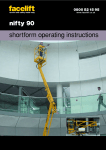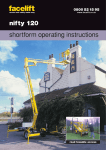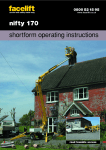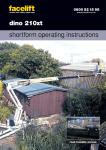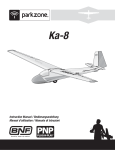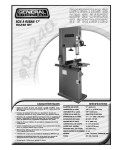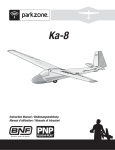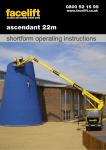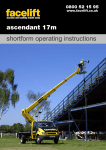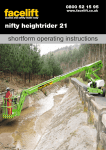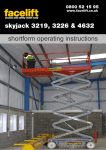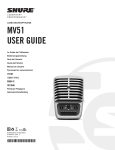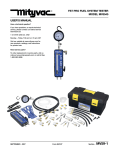Download shortform operating instructions
Transcript
0800 52 15 95 www.facelift.co.uk omme 2500ebz shortform operating instructions road towable access This book is designed as a guide to enable you to start work quickly and safely. It is not intended to replace the full manufacturer’s operating instructions (a copy of which should be with your machine) which should be read and understood by anyone operating the machine. SAFETY TIPS ALWAYS NEVER • Inspect your machine before use. • Use an unsafe machine. • Check all operations including ground controls. • Use an access platform to hoist loads like a crane. • Check ground conditions. • Overload cage/platform. • Check clearance from overhead obstructions (power cables, building projections etc). • Operate in strong winds (Check manufacturer’s recommendation). • Plan your task/job. • Rest the cage on a structure or object to gain extra support. • Use sole boards under your outriggers at all times regardless of ground conditions. • Stabilise and level machine before use. • Wear a safety harness connected to a suitable anchorage point inside the platform. • Operate all controls smoothly. • Warn other people that you are there by means of flashing lights, sign and cones. • MAKE SAFETY YOUR No.1 PRIORITY. • Attach your safety harness to a structure outside of the platform. • Throw or drop anything from the platform. • Use boxes, ladders or stand on handrails to gain additional height, if you can’t reach, you need a bigger machine. • Let an untrained person operate the access platform. • Take unnecessary risks (hospitals and graveyards are full of dead heroes!) In the unlikely event that your machine develops a fault please contact the Facelift Tech Team on 01444 881100 CONTENTS Starting OMME Lift ................................................1 Handling and Conduct During Operation ..............3 Notes ....................................................................4 STARTING OMME LIFT 1. 1.13 If the basket is not completely horizontal, the lift will level automatically. This happens, when the lift handles are activated. INSTRUCTIONS OMME LIFT TYPE 2500 EBZ/EDZ/EPZ/EBDZ/EBPZ 1.14 If the basket is more than 100 oblique, all functions are interrupted. Levelling is made manually by means of an assistant. Please see point B in “emergency lowering”. 1.1 The lift may only be placed on firm ground. The wind velocity must not exceed 10 in/sec. 1.15 The lift is equipped with manually operated emergency stops (1), which interrupt the lift, when activated. 1.2 Only persons, who meet the national demands to persons operating the lift, may operate,it. 1.16 The lift is equipped with a rotation stop, which only permits one rotation to each side. If the rotation stop is activated, the lift must be rotated one turn backwards. 1.3 On the working site there must always be persons present, who in any emergency situation can bring down the operator of the lift. 1.4 When working on public roads, warnings and barriers must be mounted in accordance with the national traffic code. 1.17 At too low voltage on the batteries, the lift movements are interrupted. To enable the leaving of the work basket in a secure way, you can make the lift operate for yet another short while: Push the emergency stop (1) and release it again. Hereafter the work basket must be lowered immediately, so that you can leave the basket. If possible, bring the lift into transport position. Before using the lift again, the batteries are to be charged. 1.5 IMPORTANT! When the lift is in operation, the user must always take care, that no persons are within the working area of the tower – squeeze danger. 1 .6 Release the lift arm by means of the lock fittings (A) under the basket by pressing the pawl. Lift up in the handle and free the eye from the hook. 1.18 If the lift stops during work due to other operation errors, it is possible to bring down the basket by emergency lowering. Please see emergency lowering. 1.7 Activate the main switch (B). 1.8 Turn key reverser (2) to “stabilizer operation” (2a). The 4 red (7b) lamps for stabilizer control will now shine. a. Lower the stabilizers by means of the 4 control handles (C). b. The stabilizers in front must always be lowered first (the handle in front). When the stabilizers are raised again, the stabilizers at the back must always be raised first. c. 1.19 After having used the lift, place it in transport position. The main switch (B) and the key reverser (2) are interrupted (2b). When leaving the lift, secure it against being used by unauthorized persons. Bring the key with you. 1.20 When using power supply for charging or for work in the basket, be careful that the cable is not damaged during propulsion or rotation. Lower the stabilizers, until the wheels are free from the ground, and the lift position is horizontal. Check by means of the spirit level (D). If the placing is correct, the 4 lamps (7b) must now be switched off (pressure on all 4 stabilizers). Place key reverser in position lift operation. Now the green lamp (7a) for lift operation must shine. The lift is now ready for use. 1.21 On lifts with propulsion, this is connected by turning the key reverser (2) into stabilizer operation (2a) and by the handle to the left on the block with the stabilizers (C). Connecting is downwards and declutching is upwards. 1.9 Turn key reverser (2) to position “operation from basket” (2d). Bring the key with you in the basket, and put it into the key switch of the basket. Then turn the key to position 1. The lift is now ready for “operation from basket”. IMPORTANT WHEN THE SELF-PROPULSION IS DISCONNECTED, THE HAND BRAKE MUST BE PULLED. 1.10 Remember, that because of the construction elasticity, a movement does not stop immediately, when releasing the corresponding handle. Avoid bumping into immovable parts, such as walls, masts or trees. Thus start and stop all movements by means of the adjusting knob (3) for low speed. 1.11 As an extra safety the lift is equipped with a warning device, which is activated, if the placing is no longer at its optimum during work from basket. If the sound continues, then bring the basket into transport position as soon as possible, and check if the placing of the lift is stable enough. IMPORTANT REMEMBER TO CHARGE THE BATTERIES EACH NIGHT. WHEN IT IS POSSIBLE, THE CHARGER CAN ALSO BE USED, WHEN THE LIFT IS IN OPERATION. DURING ALL WORK WITH THE LIFT, IT IS IMPORTANT TO BE AWARE, THAT THE SAFETY INSTALLATIONS ARE INTACT, AND THAT DAMAGES ARE REPAIRED AT ONCE. THE SAFETY OF THE USER IS DEPENDENT ON THE CONDITION OF THE LIFT. 1.12 If the lift reaches its highest outreach, all outwards and downwards movements are automatically interrupted. Only the movements upwards, inwards and rotation are possible. 1 fittings over the magnet valve, so that the bolt end will activate the actual magnet. Also activate MV.59 by means of the other fittings (EZ/BP/BD). 4. Turn the lift with the hand pump. 5. Open the valve on the hand pump. 6. Remove the fitting for the valve. 2.3 Lowering of the boom cannot take place, before the telescope is in. Pull out the red button on the valve block of the lifting cylinder. Take care, not to get caught, when the boom is lowered. 2. EMERGENCY LOWERING 2.4 Having emergency lowered the lift, check the lift for errors and damages. Check that all emergency lowering valves are closed. Repair errors and damages if any, before using the lift again. 2.1 If the lift stops during work, and it is not possible to locate the fault, an emergency lowering has to be made. If the fault is due to basket inclination over 10º – please see paragraph B. B – Basket inclination of more than 100 During manual emergency lowering all safety limit switches are out of operation. Therefore emergency lowering must be made very carefully and according to the descriptions below. Manual emergency lowering requires assistance from the ground. If the basket is more than 100 oblique, and the lift functions therefore do not take place, then bring the basket back in the following way: 2.2 Before emergency lowering, pump in the telescopic boom. If there are any obstacles to the boom being lowered to alighting height, use the barring gear. The tools required for emergency lowering are the red handle for the hand pump and the red emergency lowering fittings. The handles are placed on top of the tower, and the fittings are placed at the valve block. The valves are placed in the box behind the control box. (see sketch on page 13 where the valves are placed). 1. Close the valve on the hand pump. 2. Place the red extension handle on the hand pump. 3. Activate magnet valve MV49 = basket upwards or MV51 = basket downwards by means of the red fittings. Place the fittings over the magnet valve, so that the bolt end activates the actual magnet. Also activate MV.59 by means of the other fittings (EZ/BP/BD). 4. Bring the basket into horizontal position by means of the hand pump. 5. Open the valve on the hand pump. 6. Remove the fittings for the valve. Faults and damages, if any, are to be repaired, before further use of the lift. Magnet valve functions MV 41 Telescopic boom in MVO1 Rotation right MVO3 Rotation left MV49 Basket upwards MV51 Basket downwards MV59 Lift control (EZ/BP/BD) IMPORTANT WHEN EMERGENCY LOWERING, ALWAYS REMEMBER TO DRIVE THE TELESCOPIC BOOM IN FIRST. Follow the below instructions: Manual operation of the telescopic boom 1. Close the valve on the hand pump. 2. Place the red extension handle on the hand pump. 3. Activate magnet valve MV41 mechanically by means of the red bow (please see the sketch on page 13). Squeeze the bow over the valve, so that the tiny bolt activates the sleeve valve and opens the valve through the opening of the magnet coil on the valve. Also activate MV.59 by means of the other fittings (EZ/BP/BD). 4. Pump in the telescopic boom. 5. Open the valve on the hand pump. 6. Remove the fittings for the valve. 3. Manual operation of the barring pear MANUAL CONTROL OF STABILIZERS 1. Close the valve on the hand pump. Only raise the stabilizers manually, when the boom has been attached to the transport fittings. 2. Place the red extension handle on the hand pump. 1. Close the valve on the hand pump. 3. Activate magnet valve MVO3 = left or MVO1 = right by means of the red fittings. Place the 2. Place the red extension handle on the hand pump. 3. Activate the magnet valve MV.60 mechanically by 2 6. means of the red fittings (see instruction), which is placed over the magnet valve, so that the bolt end activates the actual magnet. The assistant keeps the fittings in while the hand pump is activated. 4. If faults occur in the controLsystem the lift may be switched off by means of one of the red emergency switches. On erroneous activation of the emergency switch it is possible Raise the stabilizers one by one with the hand pump by activating the handle for the stabilizer in question. The assistant takes care of the valve- and pump function. 5. Remove the valve fittings. 6. When all stabilizers are raised, open the cock on the hand pump. FAULTS to switch it off by turning the switch 7. FURTHER PRECAUTIONS A daily functional test must be made on the lift. (cf. page 18, Maintenance). The user should acquaint himself thoroughly with all functions and familiarize himself with: – emergency stop – emergency lowering valves – manual operation of turn table, telescopic boom and basket levelling HANDLING AND CONDUCT DURING OPERATION 1. 2. REQUIREMENTS TO PERSONS OPERATING THE LIFT 8. – rotation stop – lowering at too low voltage AFTER USE Anybody operating the lift must be informed about the national safety regulations regarding work platforms. When lift operation is finished the lift must be secured The lift may only be operated by persons at least 18 years old who have had instruction in using the lift, and who have proved their proficiency to the person responsible. switch is switched off and the keys are removed. against being used by unauthorized persons. The key 9. LIFTS WITH EXTRA PUMP CAPACITY PERMISSIBLE LOAD/LATERAL FORCE The permissible load (200 kg / 2000 N in the basket) and the permissible work basket lateral force (30 KP/300 N) must not be exceeded. 3. TRANSPORT When changing place of operation the lift must be in transport position, and the stabilizers must be all up. When the lift is towed behind a vehicle, the boom must be locked to the drawing rod. When key switch (2) is either placed in position (2c) or in position (2d), it is possible to switch between low! high speed 4. on telescope out by means of the adjusting knob (14). HIGH-VOLTAGE LINES Working near high-voltage lines is prohibited. When working near uninsulated low-voltage lines, do not go closer than 1.5 m to the live lines. 10. LIFTS WITH PROPULSION (EXTRA-EQUIPMENT) It is important always to mount the delivered nose wheel, In general, the national safety standards for work platforms apply. 5. when self-propulsion is used. SAFETY BELT CoupIing and uncoupling of the self-propulsion is made by means of the handle, as shown below. Remember to place The lift is prepared for use of safety belt. When using a safety belt, fasten this to the basket. the key reverser (2) in position “stabilizer control” (2a). 3 NOTES NOTICE THE HAND BRAKE MUST ALWAYS BE ACTIVATED, WHEN THE SELF-PROPULSION IS UNCOUPLED. 4 NOTES 5 0800 52 15 95 www.facelift.co.uk operator training centre When hiring access equipment we strongly recommend taking advantage of one of our one day operator training courses As Facelift is an accredited IPAF (Independent Powered Access Federation) training centre you can be sure that your staff will be trained to a high standard and receive an internationally recognised qualification. Courses can take place on your own premises or at one of our training centres, situated in Hickstead, Iver, Southampton and Liverpool. We can train your personnel on any of the following equipment: (SL) Scissor Lift (SPB) Self Propelled Boom (VMP26) Truck/Van mounted to 26m (VMP200) Truck mounted over 26m (VPP) Vertical Personnel Platform (TP) Trailer/Push around The one day course* covers site safety, practical demonstration, sole usage and site risks and includes a theory test. *(two day course for VMP200) Successful candidates are issued with the IPAF PAL card, widely accepted by both the CITB and Health And Safety Executive. For further information or to arrange a training course call us today on: 0800 0 72 55 72








